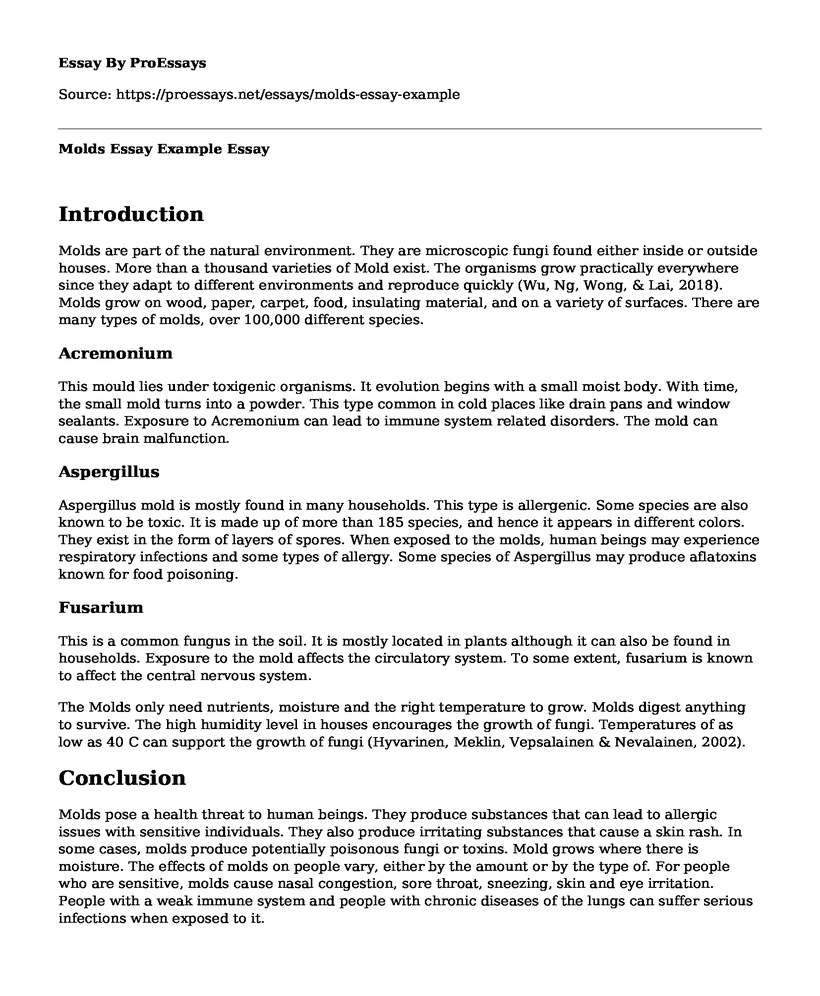Introduction
Molds are part of the natural environment. They are microscopic fungi found either inside or outside houses. More than a thousand varieties of Mold exist. The organisms grow practically everywhere since they adapt to different environments and reproduce quickly (Wu, Ng, Wong, & Lai, 2018). Molds grow on wood, paper, carpet, food, insulating material, and on a variety of surfaces. There are many types of molds, over 100,000 different species.
Acremonium
This mould lies under toxigenic organisms. It evolution begins with a small moist body. With time, the small mold turns into a powder. This type common in cold places like drain pans and window sealants. Exposure to Acremonium can lead to immune system related disorders. The mold can cause brain malfunction.
Aspergillus
Aspergillus mold is mostly found in many households. This type is allergenic. Some species are also known to be toxic. It is made up of more than 185 species, and hence it appears in different colors. They exist in the form of layers of spores. When exposed to the molds, human beings may experience respiratory infections and some types of allergy. Some species of Aspergillus may produce aflatoxins known for food poisoning.
Fusarium
This is a common fungus in the soil. It is mostly located in plants although it can also be found in households. Exposure to the mold affects the circulatory system. To some extent, fusarium is known to affect the central nervous system.
The Molds only need nutrients, moisture and the right temperature to grow. Molds digest anything to survive. The high humidity level in houses encourages the growth of fungi. Temperatures of as low as 40 C can support the growth of fungi (Hyvarinen, Meklin, Vepsalainen & Nevalainen, 2002).
Conclusion
Molds pose a health threat to human beings. They produce substances that can lead to allergic issues with sensitive individuals. They also produce irritating substances that cause a skin rash. In some cases, molds produce potentially poisonous fungi or toxins. Mold grows where there is moisture. The effects of molds on people vary, either by the amount or by the type of. For people who are sensitive, molds cause nasal congestion, sore throat, sneezing, skin and eye irritation. People with a weak immune system and people with chronic diseases of the lungs can suffer serious infections when exposed to it.
References
Segers, F. J., van Laarhoven, K. A., Huinink, H. P., Adan, O. C., Wosten, H. A., & Dijksterhuis, J. (2016). The indoor fungus Cladosporium halotolerans survives humidity dynamics markedly better than Aspergillus niger and Penicillium rubens, despite less growth at lowered steady state water activity. Applied and environmental microbiology, AEM-00510.
Wu, H., Ng, T. W., Wong, J. W., & Lai, K. M. (2018). Environmental Sustainability and Mold Hygiene in Buildings. International journal of environmental research and public health, 15(4), 681.
Hyvarinen, A., Meklin, T., Vepsalainen, A., & Nevalainen, A. (2002). Fungi and actinobacteria in moisture-damaged building materials-concentrations and diversity. International Biodeterioration & Biodegradation, 49(1), 27-37.
Cite this page
Molds Essay Example. (2022, Jul 28). Retrieved from https://proessays.net/essays/molds-essay-example
If you are the original author of this essay and no longer wish to have it published on the ProEssays website, please click below to request its removal:
- Application Letter for Nursing Course. Example
- Annotated Bibliography: Inhaled Aerosol Medication
- Essay Sample on Shift Nurses Handoff Report and Patient Safety
- Research Paper on Foster Care Services: A Viable Intervention for Neglected Children
- A Childhood Dream Fulfilled: Essay Sample on My Journey to Becoming a Nurse
- Essay Example on School-Age Child Care: Quality Matters for Kids' Growth
- Reflective Essay in Nursing: Examining Cultural Contexts







